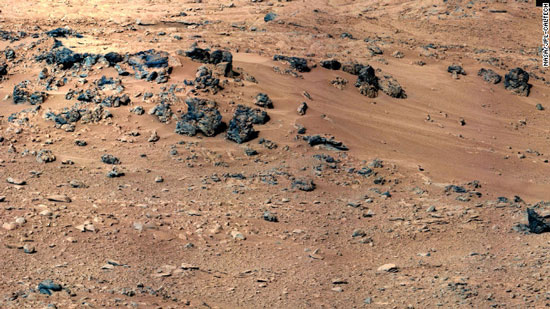Curiosity robot analyzes sand on Mars
American Curiosity autonomous robot will sample Mars sand for analysis in its "lab".

Curiosity will collect sand from the area in the image for analysis. (Photo: NASA)
Today the self-propelled robot will use a tool shaped like a mason's fly to shovel sand and put a small piece of sand inside the machine for analysis.
It will shake and sieve the sand sample to ensure that only the smallest particles (smaller than the diameter of the human hair) will enter the analyzer.
Theoretically, this seems to be a simple operation, but engineers of the US Aerospace Agency (NASA) said it is a complicated process and they need more time to find the best way. to implement it.
The purpose of sand sample analysis is to understand the chemical and mineral composition of sand on Mars.
Curiosity has moved a total of 484m since it landed on the Gale hole on Mars's surface on August 6. It will have to move another 176 m to reach a position that scientists call Glenelg. When it comes to Glenelg, it will perform the analysis of Mars's environmental conditions in the past.
- More than 6.5 operations on Mars, NASA has come up with a new way to take advantage of the Curiosity robot
- NASA robots search for 'treasure' on Mars
- NASA declares: Humans can live on Mars!
- Unique photo
- Thanks to Curiosity for the great photos that were just sent from Mars
- Curiosity robot moves by itself
- Mars is hotter than 0 ° C
- Continue to bring Curiosity robots to Mars
- NASA exploration robots are torn by Mars
- Mars explorer robot fails a sensor
- Top 10 photos of Mars
- Curiosity robot has moved to the foot of Sharp mountain
 Van Allen's belt and evidence that the Apollo 11 mission to the Moon was myth
Van Allen's belt and evidence that the Apollo 11 mission to the Moon was myth The levels of civilization in the universe (Kardashev scale)
The levels of civilization in the universe (Kardashev scale) Today Mars, the sun and the Earth are aligned
Today Mars, the sun and the Earth are aligned The Amazon owner announced a secret plan to build a space base for thousands of people
The Amazon owner announced a secret plan to build a space base for thousands of people